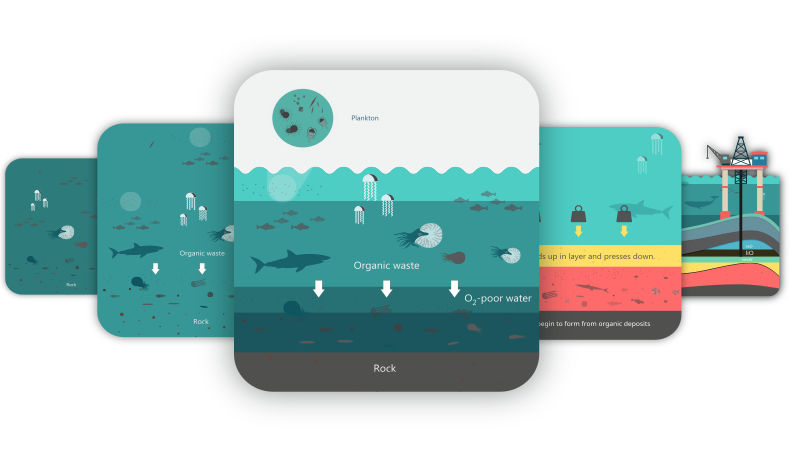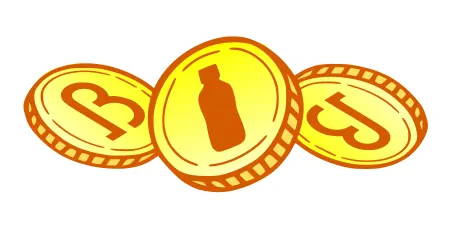Based on real world ecological value, the Brikcoin manual-blockchain energizes our petro-capital transition to a regenerative world.
Brikcoins (BRK / ß) are generated by human work and based on ecological value.
More than just numbers in ledger, every brikcoin correlates directly with plastic that has been secured from from polluting the biosphere— and permanently removed from high-emissions industries. In the same way that ancient gold and silver coins have a value in and of themselves, Brikcoins are based on the ecological value that they represent.
We call this a proof-of-value, manual manual-blockchain.
Ecological Value
In following the Earth's example of carbon concentration we can generate authentic ecological and utility value.
Two billion years ago, Earth's atmosphere was full of carbon dioxide. The planet's climate was unstable and its surface barren. However, steadily the atmosphere's CO2 was cycled into carbon-based life, which, generation after fallen generation, was buried and secured into the ground. As more and more carbon ended up sequestered, there was less and less CO2 in the atmosphere. Steadily the climate stabilized and Earth's biosphere blossomed.

Today, our petroleum based plastic comes directly from these ancient underground carbon stores. As a form of carbon, what we do with our plastic can be of ecological benefit— or not.

When plastic is dumped, it degrades into dangerous micro-plastics. When plastic is incinerated it returns to the atmosphere as CO2. And when plastic that is processed by industry it causes factories to spin and churn, resulting in more emissions and more plastic products.
However, by following Earth's example of securing, concentrating and sequestering our carbon we can keep our plastic out of the biosphere and out of industry. This work has important ecological value insofar as it avoids pollution, disperses benefit, and supports biodiversity.
This process of plastic sequestration is defined as a manual, net-zero, non-industrial process (see the wikipedia page). In order to be sequestered, the resulting secured-plastic must meet the criteria of plastic sequestration to ensure that it is in fact green.
One of the most universal and accessible means of plastic sequestration is ecobricking.
Ecobricked plastic, if it has been authenticated to have met the criteria of plastic sequestration, embodies an ecological and utility value. This value can be quantified by the weight of the plastic sequestered within it.
Brikcoins are based on the ecological value of Authenticated Ecobrick Sequestered plastic (AES plastic).
Learn More
ℹ️ Wikipedia article: Plastic Sequestration.
ℹ️ The GEA's criteria for plastic sequestration.
ℹ️ The Long Story of Plastic.
ℹ️ More on: AES Plastic.
ℹ️ The theory of Earthen Ethics of following Earth's example.
Proof of Value
Brikcoins are generated through the manual process of authenticating ecobrick sequestered plastic.
Brikcoins are based on the ecological value of sequestered plastic— a concept which is based on following Earth's example of carbon care (the principles of Earthen ethics). Ecobricked plastic, in order to be considered sequestered, must meet the criteria of plastic sequestration developed by the Global Ecobrick Alliance.
The final criteria of plastic sequestration, is that of independent authentication: confirmation that all the other criteria have been met. In order to authenticate ecobricks that have been made around the world as sequestered plastic, the GEA maintains the GoBrik platform. There, every ecobrick logged is peer reviewed by the ecobricker community to confirm whether it meets GEA ecobrick standards.

Only when the peer review of an ecobrick is successful, is the plastic within it deemed to have been sequestered. This fulfils the final criteria of plastic sequestration (authentication), thereby both validating and finalizing the ecobrick's ecological value. The brikcoins that represent this value are then generated in a block on the brikchain.

In this way, Brikcoins avoid another pitfall of other blockchain currencies. Rather than favor those who have capital to invest, as a non-capital, manual, and community-powered process, brikcoins favor those willing to work with their hands to make a meaningful ecological contribution regardless of their wealth or location.

How it works
Brikcoins are generated and verified by human labour.

Step 1: Ecobricking
The brikcoin manual-blockchain revolves around the ecobricking of used plastic. Ecobricking is an established means of securing plastic. It is a time-consuming, labor-intensive process that is most effectively done manually. If done properly an ecobrick can be used for long-term building applications; ensuring that its plastic is secured from industrial processing and release into the biosphere.
Once complete, ecobrickers log their ecobrick on the GoBrik platform. A serial number is given by the system and the ecobricker enscribes this permanently on the ecobrick. A photo of the ecobrick with the serial number is taken and the logging completed.
The logged ecobrick is then automatically queued for review. The ecobricker is awarded credits that allow them to validate other ecobricks that have been logged.
Step 2: Validation
The GEA has defined standards for an ecobrick. Only when a packed bottle meets these standards is it considered an ecobrick, and only then is the plastic it contains considered sequestered.
Using one validation credit, ecobrickers are entitled to validate one ecobrick from the queue. The validator proceeds through a three-step process of reviewing the ecobrick, to ensure that it meets the criteria and standards of plastic sequestration. In total, each ecobrick is reviewed by three validators in the community.
Step 3: Authentication
An algorithm calculates a validation score based on the review. The three validation scores are averaged and if the average exceeds the minimum threshold, the ecobrick is authenticated. Brikcoins are then generated and issued to the validators and the GoBrik Central Reserve based on the weight of the ecobrick.
The amount of Brikcoins generated is a function of the weight of the authenticated ecobricked plastic. This 'plastic standard' is pegged to a ratio of 1 BRK (ß) to 100g of AES plastic. For example, a 322g ecobrick will generate 3.22 ß, while a 0.41 kg ecobrick will generate 4.10 ß. As the blockchain operates however, this valuation fluctuates. See the live Brikchain Explorer for the latest valuation.
Centralized Decentralization
The Brikcoin manual-blockchain is presided over by the Global Ecobrick Alliance
The brikcoin manual-blockchain is developed and maintained by the Global Ecobrick Alliance in pursuit of its mission and vision of plastic transition. As a not-for-profit Earth Enterprise, the GEA is guided by a mandate of achieving net-green ecological impacts and redistributing excess revenue back to the global ecobrick movement.

Through a combination of enterprise structure and server infrastructure, we aim to minimize our grey ecological impacts and maximize our collective green impact.

The brikcoin manual-blockchain is permissioned, meaning that its ledger is centralized on GEA managed databases. This structure was elected to minimize the impact of the servers supporting the blockchain, while at the same time maximize the blockchain's empowerment of the decentralized global ecobrick movement.
White Paper
The Commodification of Sequestered Plastic
On Earth Day 2020, the GEA released version 1.0 of the Ecobricks & Brikcoin Whitepaper, on The Commodification of Manually Sequestered Plastic. The 32-page document is the work of half a dozen contributors specializing in fields ranging from micro-plastic research, alternative currencies, philosophy, community development, and database development.
The white paper lays out the framework for basing the brikcoin currency on the ecological value of plastic sequestration.
📥 Download: The Commodification of Sequestered Plastic
📄 GEA White Paper | PDF | 2.1 MB
The white paper is updated as of March 2022 to reflect three years of beta-usage by our 50,000 gobrik users, over 150,000 ecobricks and a pool of over 250,000 ß (as of March, 2022).
The Brikchain
Brikcoins are possible because of the proof-of-value manual blockchain that serves as its foundation. This system is affectionately known as the brikchain. The brikchain is the full ledger of transactions generated by the authentication of ecobricked plastic around the world on the GoBrik platform. GoBrik and the Brikchain are maintained and developed by the Global Ecobrick Alliance as a for-Earth, non-profit enterprise.
As a non-capital, manual process, Brikcoins favor anyone anywhere willing to work with their hands to make a meaningful ecological contribution.
🔎 Browse the Brikchain
The live chain of transactions and ecobricks.

Valeur actuelle du Brikcoin en direct :
⬤ 96.70g AES
Prix actuel en 2024 pour 1 kg de plastique AES :
2.40 USD
Circulation totale :
370,156.62 BRK
Les Brikcoins (BRK / ß) sont marchandisés en valeur écologique mesurée en kilogrammes de plastique écologique séquestré authentifié (AES).

Une Alliance Mondiale
Le Global Ecobrick Alliance (GEA) se consacre à l'accélération de la transition plastique en soutenons les fondements techniques et intellectuels du mouvementd'écobriquage.
ℹ️ À propos de nous
Entreprise terrestre
En divulguant nos impacts sur le carbone, le plastique et la biodiversité et en veillant à ce qu'ils soient nets verts, la GEA s'engage envers for-Earth Enterprise
D'une Éthique Terrestre
Les écobriques sont basées sur les cinq principes de l'exemple terrestre
📗 Résumé





